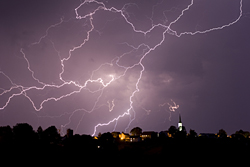| Weather Fact: | The coldest temperature ever recorded was a negative 126.9 degrees fahrenheit in Vostok Station, Antarctica. |
Lightning is an atmospheric discharge of electrical energy which typically occurs during thunderstorms. But what does that mean!?

There is free electricity in the air and the clouds all the time. This electricity is carried around by protons and electrons. Protons carry positive electricity, and electrons carry negative electricity.
As we know, clouds are made up of tiny particles of water which bump into one another and collect together. Within a storm cloud, the positive protons are light and rise to the top of the cloud while the negative protons get heavier and collect at the base of the cloud.
As each opposing group of particles gets bigger, the magnetic power of attraction between the positive and negative electrical charge grows too strong, and the particles discharge their energy at each other, creating a path for the Electricity to travel through the air.

The negative particles at the base of the cloud seek out positive particles on the ground, creating a channel of air called a Leader. The air within the Leader is charged with negative electricity, and as it travels to the ground it attracts ground based air channels called Streamers.
When the Leader and the Streamer channels meet, an electrical current called a return stroke travels up the path, releasing a huge electrical energy. This path of electricity is what we call Lightning.
Did You Know?Contrary to popular belief, lightning does strike the same place twice!
Did You Know?There are over 8 million lightning strikes a day around the world!
A typical bolt of lightning travels at speeds of over 20,000mph and can reach temperatures of 30,000°C. The intense heat of the lightning bolt has an immediate heating effect on the surrounding air temperature, making it hotter than the surface of the sun!
This rapid thermal heating causes the surrounding air to expand and contract, creating a shock wave of sound through the air. This sound can be heard as a loud crack or clap or a low rumble, depending on how far away the lightning occurred.
Did You Know?Calculate the distance (miles) of a Strike by counting the seconds between Flash and Thunder, and dividing by 5.

Light and sound travel through the air at different speeds. The speed of light is calculated at 186,282miles per second. The speed of sound is comparatively slower, at 786mph.
As lightning strikes, the shock wave of sound it creates travels through the air, but at a vastly reduced speed. If the sound of thunder is a loud crack or clap, it means the lightning storm is close. If the sound of the thunder is a low rumble, it means the storm is further away.
Did You Know?Light travels at almost a million times faster than sound!

